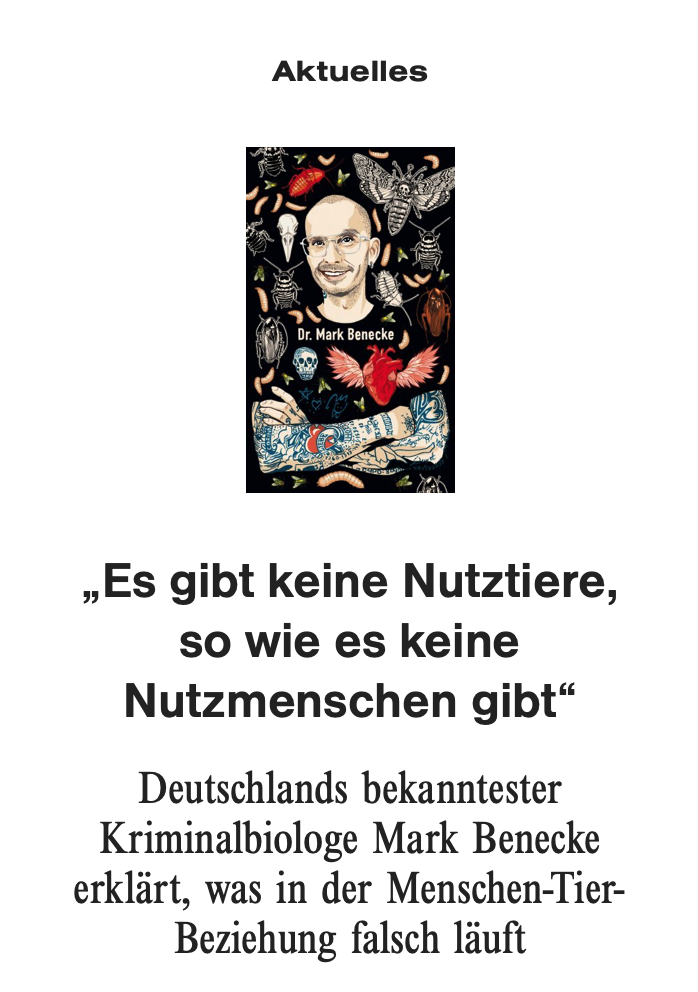Literatur zum Insekten- und Artensterben
Sonderheft der PNAS (Proceedings of the National Academy of Sciences of the United States of America) PNAS January 12, 2021, Vol 118 (2)
Einzelne Artikel
Staab M et al. (2023) Insect decline in forests depends on species’ traits and may be mitigated by management. Commun Biol 6: 338. DOI: 10.1038/s42003-023-04690-9
Seibold S et al. (2019) Arthropod decline in grasslands and forests is associated with landscape-level drivers. Nature 574: 671–674. DOI: 10.1038/s41586-019-1684-3
Dornelas M et al. (2020): Nuanced changes in insect abundance. Science; Vol 368: 368-369. DOI: 10.1126/science.abb6861
Geiger F, Bengtsson J, Berendse F, Weisser WW, Emmerson M, Morales MB, Ceryngier P, Liira J, Tscharntke T, Winqvist C, Eggers S, Bommarco R, Pärtb R, Bretagnolle V, Plantegenest M, Clement LW, Dennis C, Palmerd C, Oñate JJ, Guerrero I, Hawro V, Aavik T, Thies C, Flohre A, Hänkei S, Fischeri C, Goedhart PW, Inchausti P (2010): Persistent negative effects of pesticides on biodiversity and biological control potential on European farmland. Basic and Applied Ecology 11: 97-105. https://doi.org/10.1016/j.baae.2009.12.001
Hallmann CA, Sorg M, Jongejans E, Siepel H, Hofland N, Schwan H, et al. (2017): More than 75 percent decline over 27 years in total flying insect biomass in protected areas. PLoS ONE 12(10): e0185809. https://doi.org/10.1371/journal.pone.0185809
Hughes L, Dean A, Steffen W, Ric M (2019): This is What Climate Change Looks Like. Climate Council of Australia, ISBN 978-0-6486793-0-1 (print) & 978-0-6486793-1-8 (digital)
King MD, Howat IM, Candela SG et al. (2020): Dynamic ice loss from the Greenland Ice Sheet driven by sustained glacier retreat. Communications Earth & Environment | (2020)1:1-7
https://doi.org/10.1038/s43247-020-0001-2
Kormann U et al. (2015): Local and landscape management drive trait-mediated biodiversity of nine taxa on small grassland fragments. Diversity and Distributions, 21, 1204–1217 . DOI: 10.1111/ddi.12324
Lencioni V (2018). Glacial influence and stream macroinvertebrate biodiversity under climate change: Lessons from the Southern Alps. Science of the Total Environment 622: 563–575. Elsevier. DOI: 10.1016/j.scitotenv.2017.11.266.
Owens ACS, Lewis SM (2018): The impact of artificial light at night on nocturnal insects: A review and synthesis. Ecology & Evolution 8: 11337-11358. https://doi.org/10.1002/ece3.4557
Pearson A, Schuldt J (2014): Facing the diversity crisis in climate science. Nature Clim Change 4: 1039–1042, https://doi.org/10.1038/nclimate2415
Sanchez-Bayo F et al. (2019): Worldwide decline of the entomofauna: A review of its drivers. Biological Conservation. Volume 232: 8-27, DOI: 10.1016/j.biocon.2019.01.020
Saunders ME et al. (2020): Moving on from the insect apocalypse narrative: engaging with evidence-based insect conservation. BioScience 70: 80–89. Oxford University Press. DOI: 10.1093/biosci/biz143
Seibold S, Gossner MM, Simons NK, Blüthgen N, Müller J, Ambarli D, Ammer C, Bauhus J, Fischer M, Habel JC, Linsenmair KE, Nauss T, Penone C, Prati D, Schall P, Schulze ED, Vogt J, Wöllauer S, Weisser WW (2019): Arthropod decline in grasslands and forests is associated with landscape-level drivers. Nature 574: 671–674, https://doi.org/10.1038/s41586-019-1684-3
Thomas JA, Telfer MG, Roy DB, Preston CD, Greenwood JJD, Asher J, Fox R, Clarke RT, Lawton JH (2004): Comparative Losses of British Butterflies, Birds, and Plants and the Global Extinction Crisis. Science 303: 1879-1881
Trusch R (2019): Insektenschwund – Hintergründe, Beobachtungen, Zusammenhänge (Insect Decline – Background, Observation, Correlations). Entomologie heute 31 (2019): 229-256
USGCRP (2017): Climate Science Special Report: Fourth National Climate Assessment, Volume I [Wuebbles DJ, Fahey DW, Hibbard KA, Dokken DJ, Stewart BC, Maycock TK(eds.)]. U.S. Global Change Research Program, Washington, DC, USA, 470 pp, doi: 10.7930/J0J964J6
van Klink R et al. (2020): Meta-analysis reveals declines in terrestrial but increases in freshwater insect abundances. Science; Vol 368: 417-420. DOI: 10.1126/science.aax9931. [Zunahme im Wasser, Abnahme an Land.]
Tyson Wepprich et al (2019) Butterfly abundance declines over 20 years of systematic monitoring in Ohio, USA. PLoS ONE 14(7): e0216270. https://doi.org/10.1371/journal.pone.0216270
David Wagner et al. (2021) Insect decline in the Anthropocene: Death by a thousand cuts. PNAS January 12, 2021 118 (2) e2023989118; https://doi.org/10.1073/pnas.2023989118










